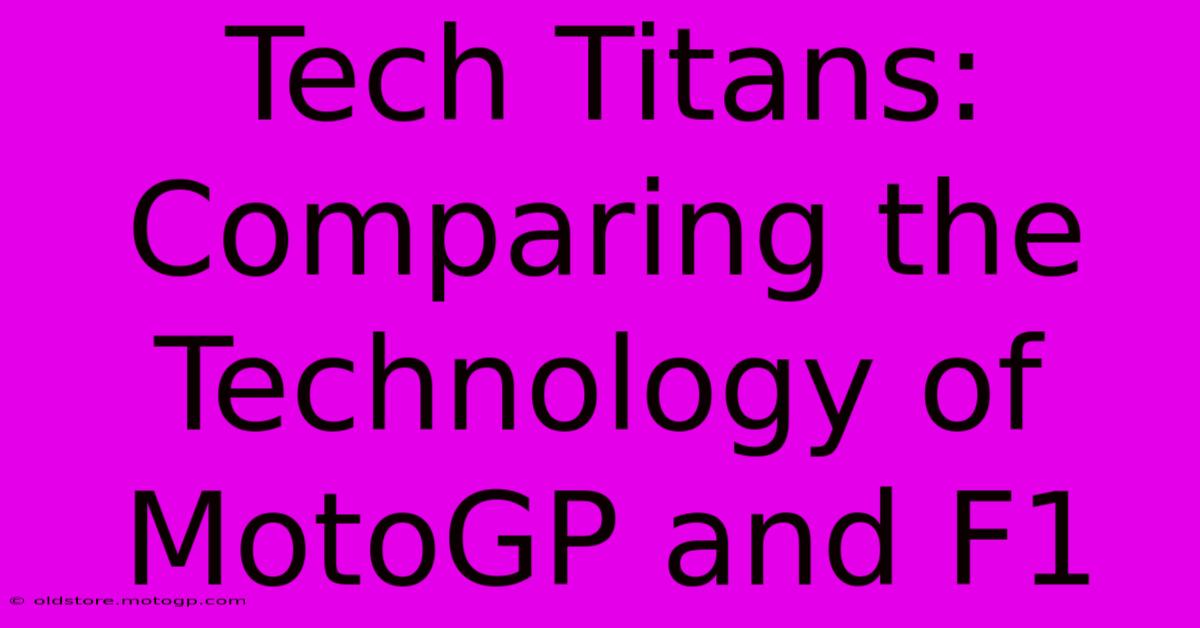Tech Titans: Comparing The Technology Of MotoGP And F1

Table of Contents
Tech Titans: Comparing the Technology of MotoGP and F1
The roar of the engines, the breathtaking speeds, the nail-biting finishes – Formula 1 and MotoGP share a captivating allure for motorsport fans worldwide. But beyond the shared spectacle lies a fascinating divergence in technology. While both pinnacle series push the boundaries of engineering, their approaches differ significantly, shaped by the unique characteristics of their respective machines. This article dives deep into the technological marvels powering these titans of motorsport, comparing and contrasting their key features.
Engine Technology: A Tale of Two Approaches
One of the most striking differences lies under the hood (or should we say, within the chassis?). F1 utilizes incredibly complex 1.6-liter V6 turbo-hybrid engines, a testament to efficiency and power recovery systems. These engines are marvels of engineering, incorporating sophisticated energy recovery systems (ERS) that capture kinetic and thermal energy during braking and exhaust, boosting performance and improving fuel efficiency. The intricate interplay of internal combustion and electric power defines the modern F1 power unit.
MotoGP, on the other hand, features powerful 1000cc inline-four or V4 engines, emphasizing raw power and high RPM. While advancements in electronics play a crucial role, the focus remains on maximizing horsepower and optimizing the engine's performance within the aerodynamic constraints of the motorcycle. Unlike F1's hybrid approach, MotoGP engines are purely combustion-based, showcasing a different technological philosophy.
Key Differences Summarized:
| Feature | F1 | MotoGP |
|---|---|---|
| Engine Type | 1.6L V6 Turbo-Hybrid | 1000cc Inline-Four/V4 |
| Power Source | Hybrid (Internal Combustion + Electric) | Internal Combustion Only |
| Power Delivery | Smooth, controlled power delivery | Raw, high-RPM power delivery |
| Focus | Efficiency, power recovery, intricate systems | Pure horsepower, lightweight design |
Aerodynamics: Downforce and Drag
Aerodynamics play a pivotal role in both F1 and MotoGP, but their applications differ considerably due to the contrasting shapes of the vehicles. F1 cars generate significant downforce through complex aerodynamic elements, such as intricate wings, diffusers, and floor designs. This downforce allows for higher cornering speeds, critical for achieving lap times on high-speed circuits.
MotoGP bikes, with their inherently less stable form, rely on a more delicate balance between downforce and drag. While wings are increasingly utilized, the emphasis is on minimizing drag to maximize straight-line speed, as the bike’s lean angle is the primary means of negotiating corners. The aerodynamic design must also account for the rider's position and its impact on airflow.
Electronics and Rider Aids: A Level Playing Field?
Both series heavily utilize advanced electronics to enhance performance and safety. F1 cars feature sophisticated traction control, anti-lock braking (ABS), and engine mapping systems carefully managed by complex software. These systems are vital for optimizing performance and handling under extreme conditions.
MotoGP bikes similarly employ sophisticated electronics, including traction control, wheelie control, launch control, and even automated gear shifting. While the sophistication of the systems is comparable, the implementation and tuning differ, tailored to the unique dynamics of two-wheeled racing.
Tire Technology: Grip and Consistency
Tire technology is another area where both series push the boundaries. F1 utilizes highly specialized slick tires designed for high-speed cornering and optimal grip Tire compounds and construction play a vital role in strategic race planning and performance.
MotoGP also employs specialized slick tires, but the demands are somewhat different. Motorcycle tires must handle lean angles and significant lateral forces while maintaining consistent grip. Tire choice and management are critical elements of race strategy in MotoGP.
Conclusion: Different Paths to the Same Goal
F1 and MotoGP represent the pinnacle of motorsport engineering, each taking a unique technological path to achieve ultimate speed and performance. While F1 embraces hybrid technology and complex aerodynamics to maximize efficiency and downforce, MotoGP prioritizes raw power and lightweight design, coupled with sophisticated electronics. Both series continuously push the boundaries of innovation, delivering exhilarating racing and technological marvels for spectators around the globe. The ongoing evolution of both series promises even more exciting technological advancements in the years to come.

Thank you for visiting our website wich cover about Tech Titans: Comparing The Technology Of MotoGP And F1. We hope the information provided has been useful to you. Feel free to contact us if you have any questions or need further assistance. See you next time and dont miss to bookmark.
Featured Posts
-
Moto Gp Starting Grid Be There From The Beginning
Feb 26, 2025
-
Detroits Hidden Gem Unlocking The Secrets Of 1330 8 Mile
Feb 26, 2025
-
F1 Austin Experience The Thrill Of Live Music And Racing
Feb 26, 2025
-
Queen Circuit Your Passport To Adventure
Feb 26, 2025
-
Tnt Moto Gp The Next Generation Of Racers
Feb 26, 2025
